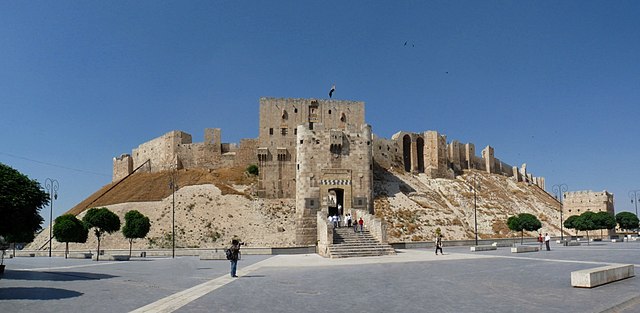The Citadel of Aleppo is a large medieval fortified palace in the centre of the old city of Aleppo, northern Syria. It is considered to be one of the oldest and largest castles in the world. Usage of the Citadel hill dates back at least to the middle of the 3rd millennium BCE. Occupied by many civilizations over time – including the Greeks, Armenians, Romans, Byzantines, Ayyubids, Mamluks and Ottomans – the majority of the construction as it stands today is thought to originate from the Ayyubid period. An extensive conservation work took place in the 2000s CE by the Aga Khan Trust for Culture, in collaboration with Aleppo Archeological Society. Dominating the city, the Citadel is part of the Ancient City of Aleppo, an UNESCO World Heritage Site since 1986 CE. During the 2010s, the Citadel received significant damage during the lengthy Battle of Aleppo. It was reopened to the public in early 2018 CE with repairs to damaged parts underway, though some of the damage will be purposefully preserved as part of the history of the citadel. The citadel was damaged by the 2023 Turkey–Syria earthquake.

The Citadel of Aleppo in 2010 CE
Hadad Temple Inside the Citadel
The inner gate of the citadel
View from outside
Aleppo is a city in Syria, which serves as the capital of the Aleppo Governorate, the most populous governorate of Syria. With an estimated population of 2,098,000 residents as of 2021, it was Syria's largest city until its population was surpassed by Damascus, the capital of Syria, the largest in Syria's northern governorates and also one of the largest cities in the Levant region.
Ancient City of Aleppo Aleppo Citadel • The entrance to al-Madina Souq Great Mosque of Aleppo • Baron Hotel Saint Elijah Cathedral • Queiq River Panorama of Aleppo at night
The old town of Aleppo
Hadad Temple inside Aleppo Citadel
Al-Qaiqan Mosque was originally a Hittite pagan temple during ancient times; in addition, a stone block with Anatolian hieroglyphs can be found on the southern wall







